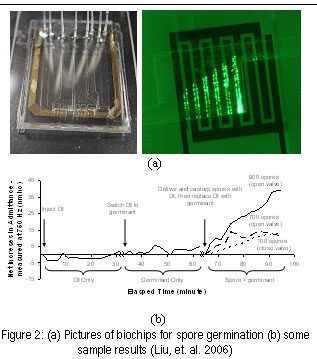Research: >> Current >> Electronic Detection of Spore Germination...
Yi-Shao Liu, Tom Walter*, Arthur Aronson*, Rashid Bashir,
School of Electrical and Computer Engineering, Department of Biomedical Engineering, *Department of Biology. Purdue University
In this NIH and USDA funded project, we are developing biochips for the concentration, viability and germination detection, and identification of Bacillus anthracis. We have developed a new impedance-based method to detect germination of spores in real time within microfluidic biochips using Bacillus anthracis Sterne spores as the model organism. During germination, the spores release chemicals, such as dipicolinic acid (DPA), calcium ions, phosphate radicals, amino acids, etc, which correspondingly increase the electrical conductivity of the medium in which the spores are suspended.

We performed macroscale measurements demonstrating that the germination of spores can be electrically detected at a concentration of about 109 spores/ml by monitoring changes in the solution conductivity. Germination was induced by introducing an optimized germinant solution consisting of 10 mM L-alanine and 2 mM inosine. We then translated these results to a microfluidic biochip (Figure 2), which was a three-layer device: one layer of polydimethylsiloxane (PDMS) with valves, a second layer of PDMS with micro-fluidic channels and chambers, and the third layer with metal electrodes deposited on a pyrex substrate. Dielectrophoresis was used to trap and concentrate the spores at the electrodes with greater than 90% efficiency, at a solution flow rate of 0.2μl/min (peak flow velocity 40cm/min). The spores were captured in deionized water, and then germinant solution was introduced to the flow stream. The detection sensitivity was demonstrated to be as low as about a hundred spores in 0.1nl, which is equivalent to a macroscale detection limit of approximately 109 spores/ml. We believe that this is the first time demonstration of this application in microfluidic and BioMEMS devices.